In this post I have decided to describe here such absolutely unpretentious rattle, I think, to link it can even a beginner!
-Do not distribute this description in the network! I hope for your understanding and humanity!!!
And yes, you can always ask me if something is not clear, I will tell, or tell me, maybe I'm missing out of sight... Also waiting for your photos ready to rattle, I'm interested to see:)
Pleasant to all knitting and smooth eyelets, well and pleasant communication to all of us!
1) Begonia yarn from Jarn art (100% cotton, 170 m in 50 gr.), from this yarn is actually tied the whole butterfly, you need three colors on the eyes (white, black and blue, or green), and six more colors on the butterfly different from me leaves. All the colors you take at your discretion!
2) Rattle. I have this usual plastic buckwheat, from stretch marks that are sold in stores, 35 mm in diameter, if not so large, you can, if there is a smaller, in the tail of a smaller insert, it I fill with beads large and metal. Pellet large and glue holes with Scotch, then another hole knitting close and nothing to fall out!
3) Synth.
4) Two Juniper beads in the horns, mm 8-10, but if they are not, you can fill the horns with just a synth, not scary!
5) Needle strong for sewing parts.
6) hook 1.75 mm at me (it is possible and 2 mm).
7) Tweezers and wooden stick (from sushi) for stuffing toys.

Symbol:
St. b/N.-a column without a scale.
VP-Air Loop.
S.S. is a connecting column (also called a half-column without a scale).
The increment is 2 St. b/N in one loop of the previous row.
Ubava-2 St. b/N, which are used together.
Start knitting from the head:
1 row: Dial 2v. P. In the second loop from the hook knitting 6st. b/N.-This is the first row. Further knitting not closing in a circle, adding in each row on 6 art. b/N.
2 row: Increase in each St. b/N., the previous row, on 1st. b/N. = 12 St. b/N.
3 row: Increase in each 2st. b/N. = 18st. b/N.
4 row: Increase in each 3st. b/N. = 24th. b/N.
5 row: Increase in each 4th. b/N. = 30st. b/N.
6 row: Increase in each 5th. b/N. = 36st. b/N.
7 row: Increase in each 6st. b/N. = 42st. b/N (Fig. 1).
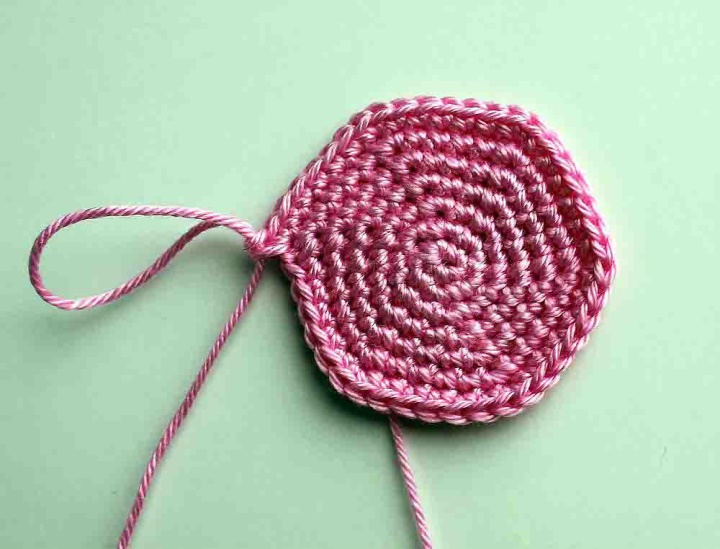
From the 8th to the 17th row, inclusive, (10 rows), knit directly on the 42 St. b/N. In a row.
Then make eyes, they are easier to sew, until the head is closed!
Eyes:
1 row: Black thread, Dial 2v. P. In the second loop from the hook knitting 6 St. b/N.
2 row: Blue, green, or brown thread. The increase in each article b/n, the previous row. = 12 St. b/N.
3 row: White thread, increase in each 2st. b/N. = 18st. b/N.
Trim, leaving the thread for stitching and glare (fig. 2).
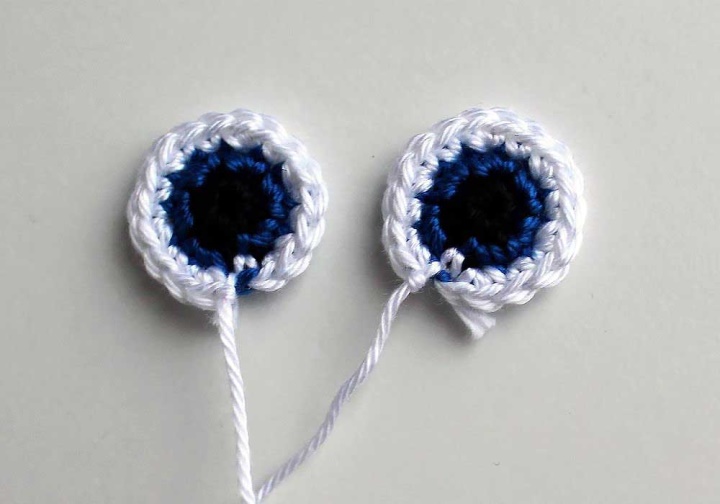
We stick the eyes in front of each other, between 7 and 13 next to the top, counting! Make the glare and, tying, hide the thread (Fig. 3).
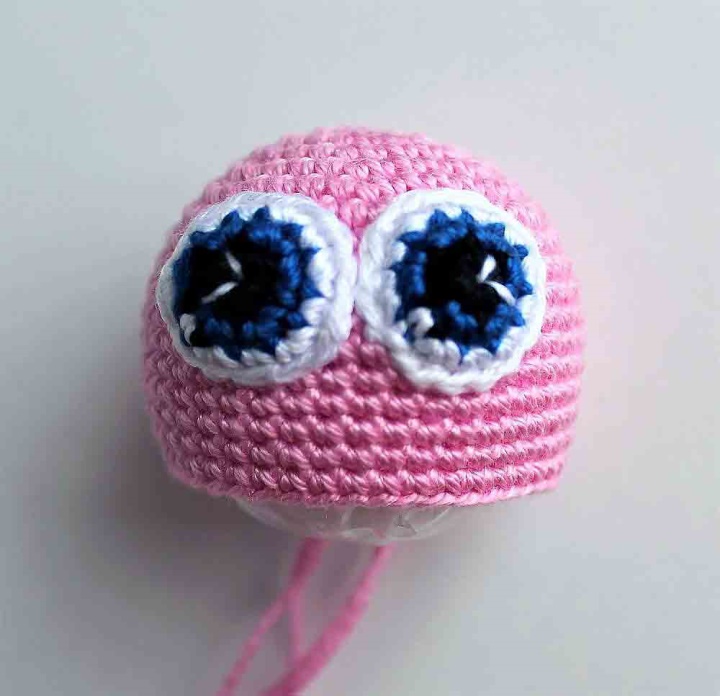
Insert in the head rattle... And knit your head further:
18 row: We start to make Ubavki, on 6st. b/N. In each row, in this every 5 St. b/N., the previous row = 36 St. b/N.
19 row: The same 6-th decreases in a row, every 4 v. b/N. = 30 v. b/N.
20 row: The same 6-th decreases in a row, every 3 v. b/N. = 24 V. b/N.
21 row: Similarly Ubavki, through every 2 St. b/N. = 18 St. b/N. (Fig. 4).
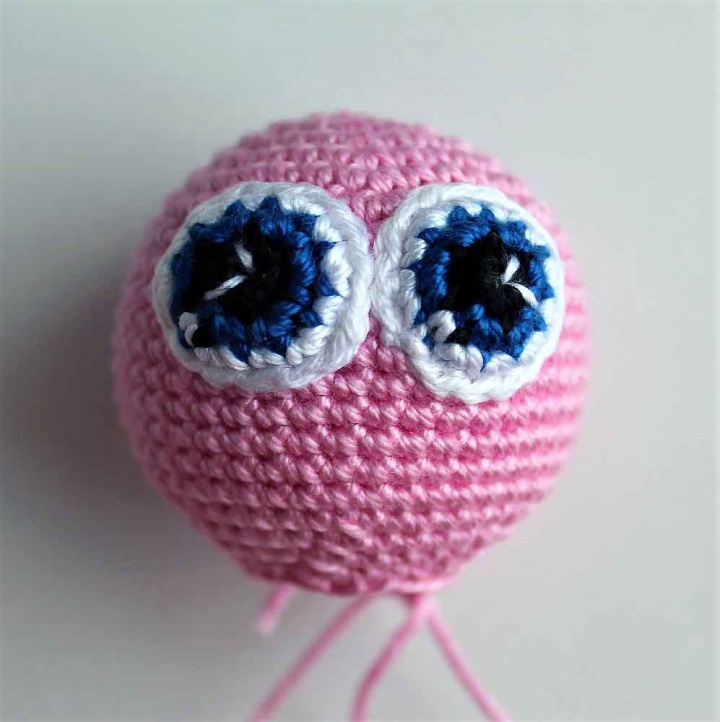
We need to get our head over here.
Horns:
1 row: Dial 2v. P. In the second loop from the hook knitting 6 St. b/N.
2 row: Increase in each St. b/N., the previous row, on 1st. b/N. = 12 St. b/N.
From 3 to 7 row, (5 rows), knit straight to 12 St. b/N.
Insert a juniper bead.
8 row: We make four ubavki in a row so: Ubavka, Ubavka, 2 St. b/N, Ubavka, Ubavka, 2 St. b/N. = 8 St. b/N.
From 9th to 12th row (4 rows), Knit straight. Trim, leaving the thread to be nailed (Fig. 5).
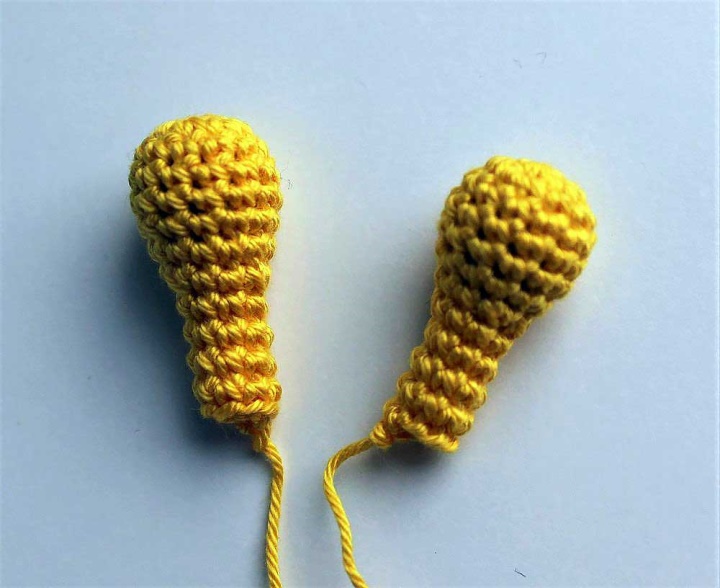
The horns are nailed (Fig. 6).
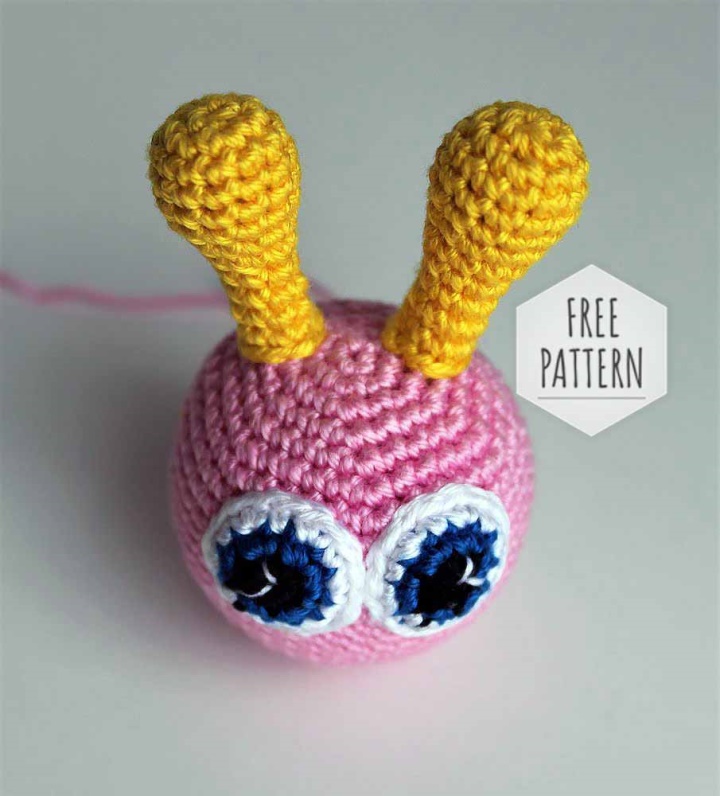
and embroider the mouth (Fig. 7).
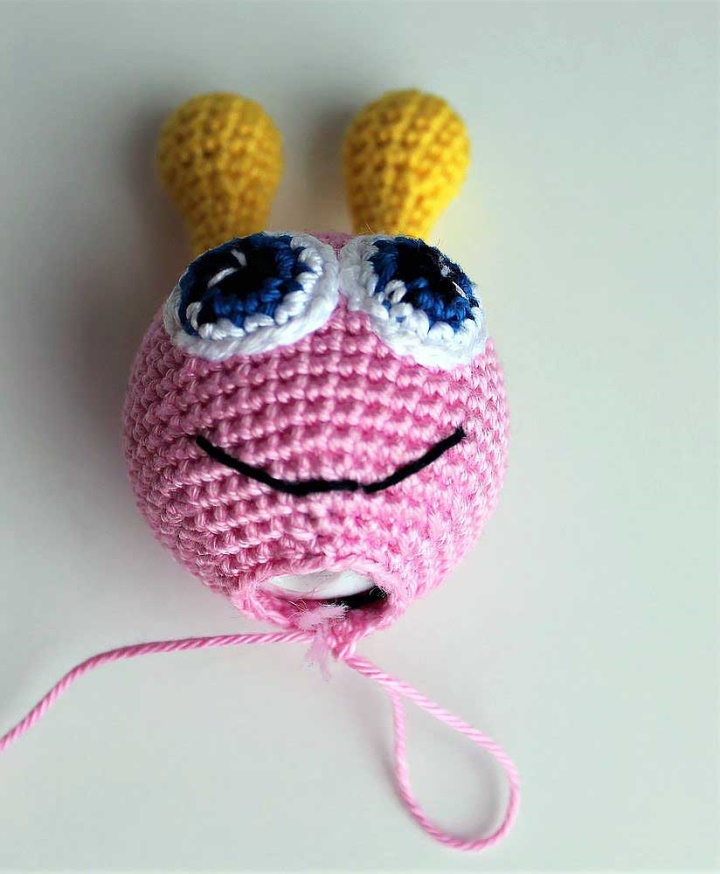
We continue to knit the body:
A thread of another color, I have it creamy, (the second circle):
22 row: Increase in each 3 St. b/N. = 24 St. b/N.
23 row: Increase in each 4 St. b/N. = 30 St. b/N.
24 row: Increase in each 5 St. b/N. = 36 St. b/N.
From 25 to 32 series, (8 rows), knit straight, on the 36 of St. b/N. In a row.
33 Series: Six decreases, every 4th loop of the previous row. = 30 St. b/N.
34 and 35 series, we also do six decreases in a row. = 18 St. b/N.
36 Series: Make three kills in a row, evenly!!! On 1.3 and 5 the previous row. = 15 St. b/N.
Turn to another thread, I have a pink (the third circle).
37 Series: We make three additions in a row, where we had the Ubavki. = 18 St. b/N.
38 Series: Increase in each 3 St. b/N. = 24 St. b/N.
39 Series: Increase in each 4 St. b/N. = 30 St. b/N (Fig. 8).
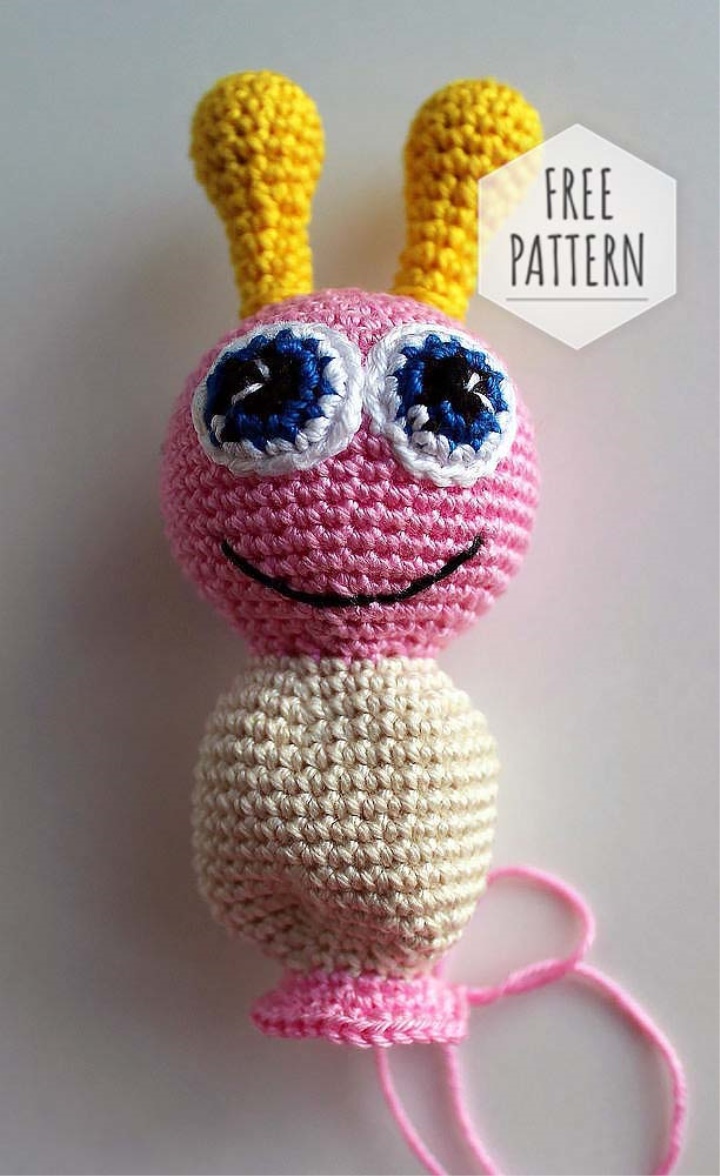
Fill tightly with the previous circle of synthesizer.
From 40 to 46 series (7 rows), Knit straight, 30 St. b/N. In a row.
47, 48 and 49 series, make six decreases in a row evenly. = 12 St. b/N.
Turn to another thread (fourth circle):
50 and 51 series, make 6 increments in a row, evenly, = 24 V. b/N.
From 52 to 57 series (5 rows), knit directly to 24 V. b/N. In a row, fill the third circle, tightly, Synpulom.
58 and 59 series, we make six decreases in a row, as well as increases. = 12 St. b/N.
60 row: Three Ubcaps, for 1.3 and 5th of the previous row. = 9 St. b/N.
Turn to another thread (the fifth circle).
61 Series: Three increments in a row. = 12 St. b/N.
62 Series: Six increments, increase in each 2 St. b/N. = 18 St. b/N.
From 63 to 66 series (4 rows), knit directly to 18 St. b/N.
Fill the fourth circle with a synth.
67 and 68 Series, we do six decreases in a row. = 6 St. b/N. Fill the fifth circle with a synth.
Close knitting, I do it so:
When we have left 6st. b/N, cut and pulling some the thread of the loop. This thread, with a hook, hooked each loop of the previous row and just tighten all 6 loops in a small circle, tie and hide the thread inside.
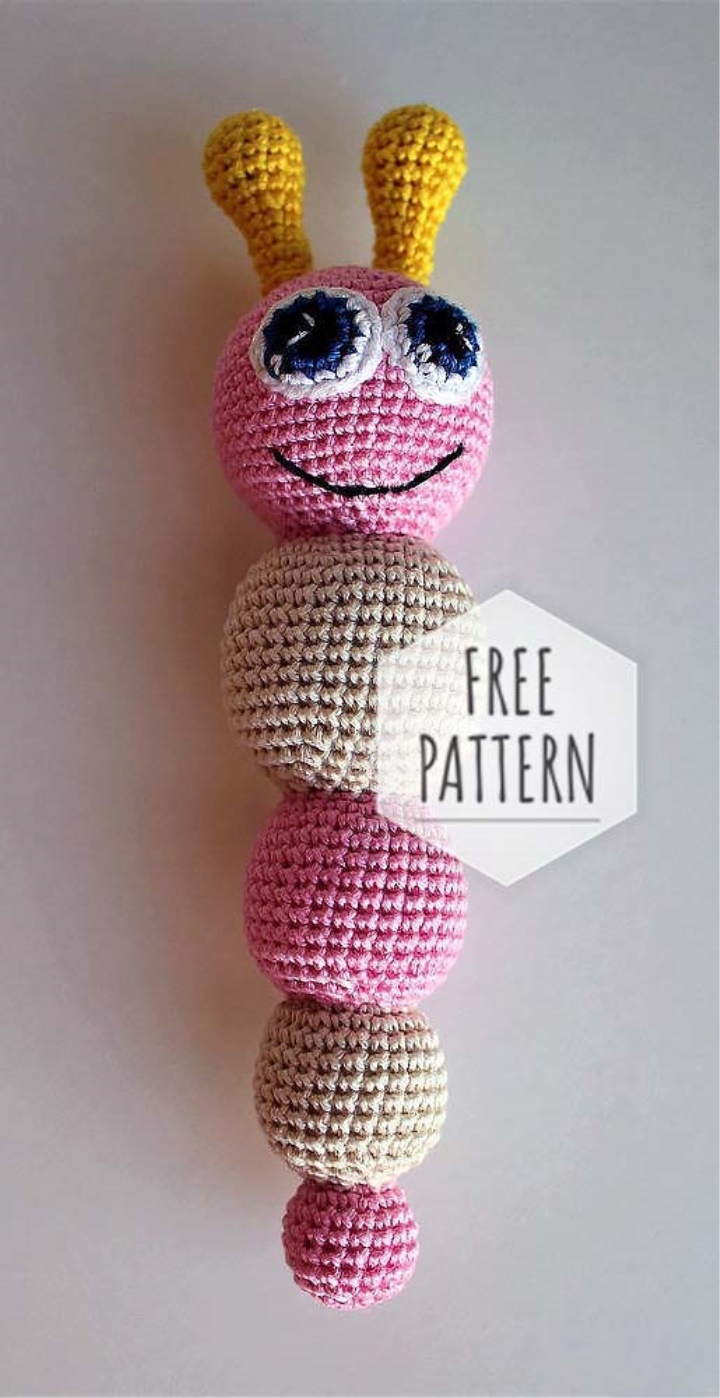
Wings:
First we will link two separate details.
1 Item:
1 row: Type 2 VP in the second loop from the hook knitting 6st. b/N.
2 row: Increase in each St. b/N., the previous row, on 1st. b/N. = 12 St. b/N.
3 row: Increase in each 2 St. b/N. = 18 St. b/N.
4 row: Increase in each 3 St. b/N. = 24 St. b/N.
From 5th to 10th row (6 rows), knit straight on 24 St. b/N. Trim, leaving a small tip of the thread, we still need it! Pull the thread.
2 Item:
1 row: Type 2 VP in the second loop from the hook knitting 6 St. b/N.
2 row: Increase in each St. b/N., the previous row, 1st. b/N. = 12 St. b/N.
3 row: Increase in each 2 St. b/N. = 18 St. b/N.
4 row: Increase in each 3 St. b/N. = 24 St. b/N.
5 row: Increase in each 4 St. b/N. = 30 St. b/N.
From 6 to 11 series (6 rows), knit straight to 30 St. b/N. Thread is not doomed, she we will continue to knit our wing (Fig. 10).
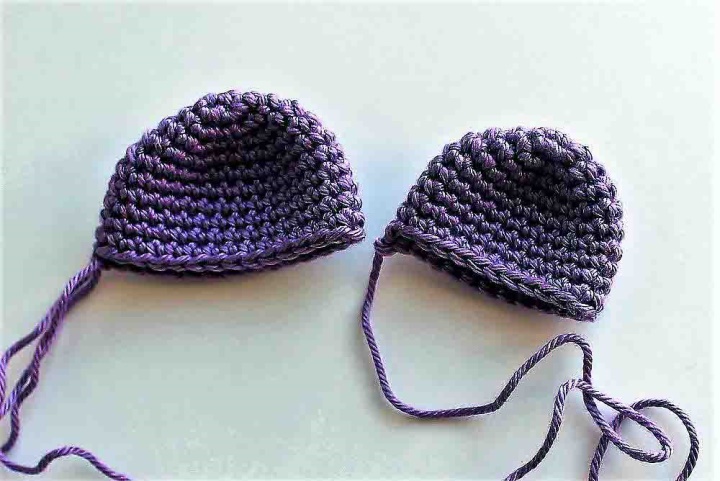
Figure 11 shows how I fold the details, and the arrow shows which way to knit.

12 row, read through the description of this range first!
12 row: Knitting 13st. b/N., and we do ubavku with the next detail (the first), as though connecting them together (Fig. 12), we bring 10 art. b/N., Ubavka (from the side of the second part is obtained), 9 St. b/N., Ubavka-connecting with the second detail, and 12st. b/N. Loop from each detail, between the details (one loop must have the tip with the thread remaining from the first part!)-this is calculate. = 49st. b/N. + 2 loops between the details (Fig. 13).
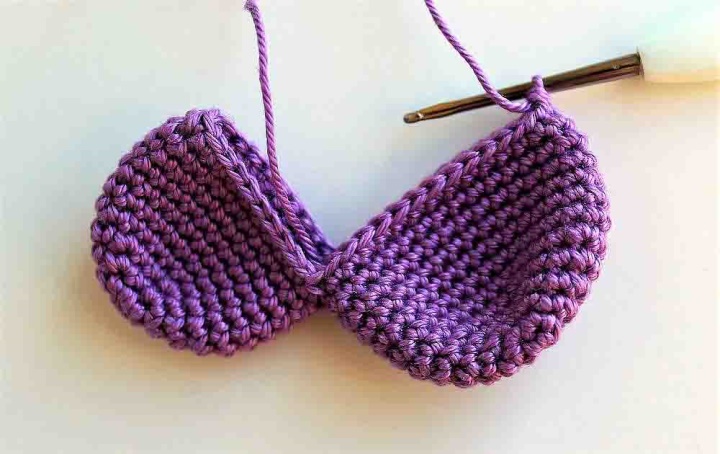
13 row: We start to do with Ubava, and knit this row with two Ubavkami from the side, the arrows on Fig. 14 shows where Ubavki (fig. 14) = 47st. b/N.
Now the thread that is left between the Detalek, sew these two skipped loops (Fig. 15). Fasten and hide the thread.
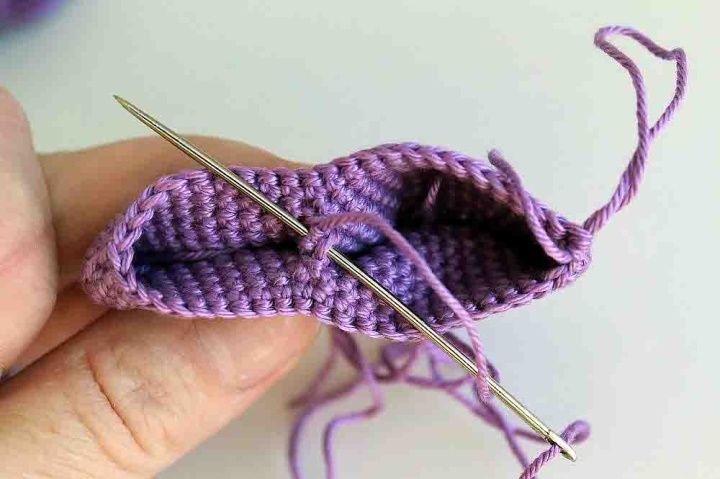
Then it is better to sew two spots, more convenient.
Specks: I have three colors.
Two spots:
1 row: Dial 2v. P. In the second loop from the hook knitting 6st. b/N.
2 row: Increase in each St. b/N., previous row, 1st. b/N. = 12 St. b/N. Trim leaving thread for stitching.
One speck:
1 row: Dial 2v. P. In the second loop from the hook knitting 6st. b/N.
2 row: Increase in each St. b/N., the previous row, on 1st. b/N. = 12 St. b/N.
3 row: The increase in each 2st. b/N. = 18st. b/N. Trim, leaving the thread for stitching (Fig. 16).
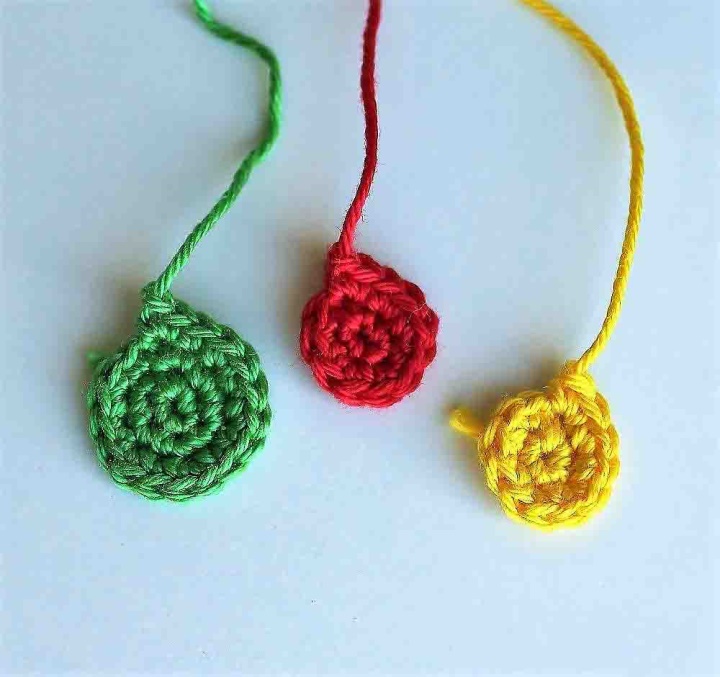
And we prishivayem different size specks (Fig. 17). I sew all the two times, cut, yarn.
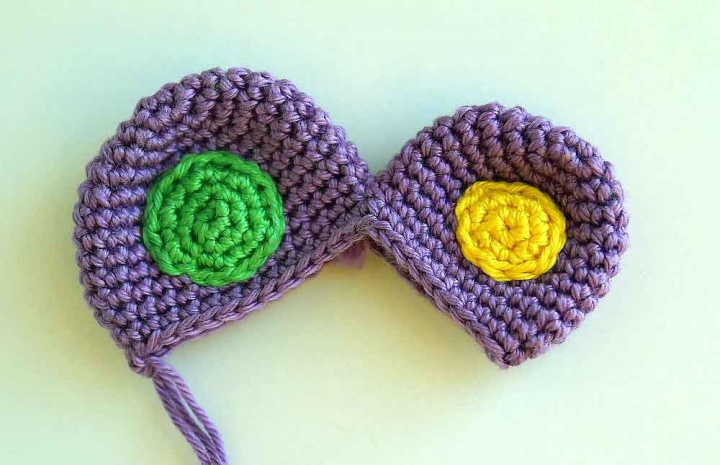
We continue to knit the wing.
From 14 to 23 series (10 rows), knitting making each row on the side of the wing. = 27st. b/N (Fig. 18).

Trim, leaving the thread to be nailed. We're going to stick another speck. Similarly knit and the second wing. And we're having our wings nailed to the calf.
If you want your wings to rustle, then inside of each winglet insert on some rustling pieces, for example, flantiki from sweets, or packing from flowers perfectly noises-I use it, in some layers (I'm sorry I do not know, as is correctly called This package, if anyone tells me, I will be glad) (Fig. 19).

Here, actually, and is ready our beauty (Fig. 20)!